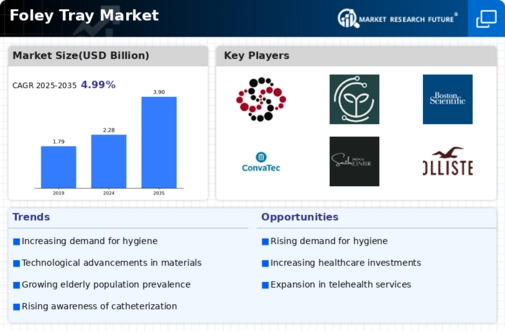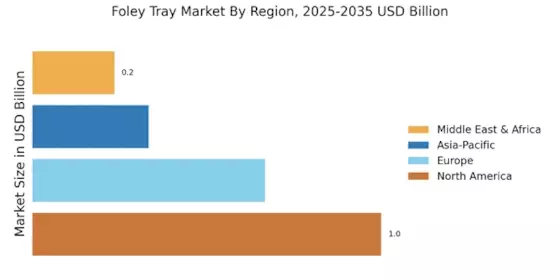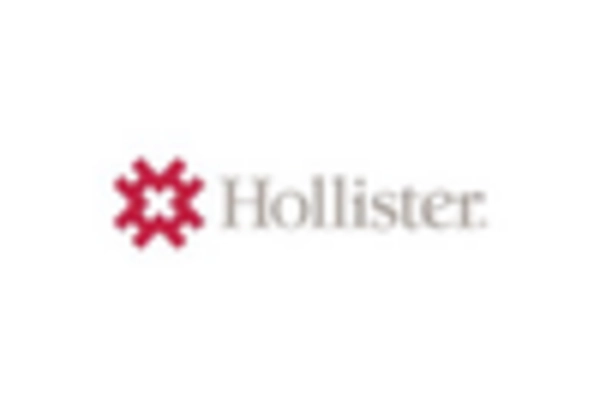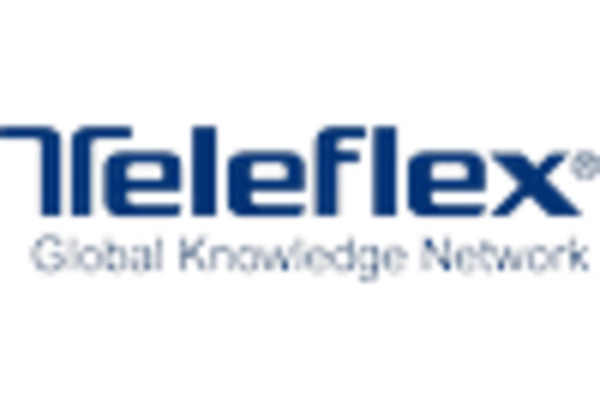Increased Focus on Patient Safety
Patient safety remains a paramount concern within the healthcare sector, significantly influencing the Foley Tray Market. The emphasis on reducing surgical site infections and improving overall patient outcomes drives the demand for high-quality, sterile surgical trays. Regulatory bodies and healthcare organizations are increasingly implementing stringent guidelines and protocols to ensure that surgical instruments are properly sterilized and maintained. This heightened focus on safety has led to a surge in the adoption of Foley trays that incorporate advanced materials and designs aimed at minimizing contamination risks. Market data suggests that the Foley Tray Market is likely to expand as healthcare providers prioritize patient safety initiatives, thereby fostering a culture of quality and accountability in surgical practices. As a result, manufacturers are compelled to innovate and enhance their product offerings to meet these evolving safety standards.
Rising Demand for Surgical Procedures
The Foley Tray Market experiences a notable increase in demand due to the rising number of surgical procedures performed worldwide. As healthcare systems evolve, the frequency of surgeries, including minimally invasive techniques, continues to rise. This trend is driven by an aging population and the prevalence of chronic diseases, which necessitate surgical interventions. According to recent data, the number of surgical procedures is projected to grow by approximately 5% annually, thereby propelling the Foley Tray Market forward. The need for efficient and sterile surgical environments further emphasizes the importance of specialized trays, which are designed to streamline the surgical process and enhance patient safety. Consequently, manufacturers are focusing on developing innovative Foley trays that cater to the specific needs of various surgical specialties, ensuring that the market remains robust and responsive to evolving healthcare demands.
Customization and Personalization Trends
Customization and personalization are emerging trends within the Foley Tray Market, as healthcare providers seek tailored solutions to meet specific surgical needs. The diverse nature of surgical procedures necessitates the development of Foley trays that can be adapted to various specialties and individual patient requirements. Manufacturers are responding to this demand by offering customizable tray configurations, which allow healthcare professionals to select the instruments and materials that best suit their surgical practices. This trend is likely to enhance the efficiency of surgical procedures and improve overall patient satisfaction. Industry expert's indicate that the Foley Tray Market may experience substantial growth as providers increasingly prioritize personalized solutions that align with their operational needs. As a result, manufacturers are encouraged to innovate and expand their product lines to cater to this evolving demand.
Technological Innovations in Medical Equipment
Technological advancements play a crucial role in shaping the Foley Tray Market. The integration of cutting-edge technologies, such as smart materials and automated sterilization processes, enhances the functionality and efficiency of Foley trays. These innovations not only improve the user experience for healthcare professionals but also contribute to better patient outcomes. For instance, the development of trays with built-in tracking systems allows for real-time monitoring of sterilization processes, ensuring compliance with safety standards. Market analysis indicates that the Foley Tray Market is likely to benefit from these technological innovations, as they address the growing demand for more efficient and reliable surgical solutions. Furthermore, as healthcare facilities increasingly adopt digital solutions, the market is expected to witness a shift towards more sophisticated Foley tray designs that align with modern surgical practices.
Growing Awareness of Infection Control Practices
The Foley Tray Market is significantly influenced by the growing awareness of infection control practices among healthcare providers. As hospitals and surgical centers strive to minimize the risk of healthcare-associated infections, the demand for specialized trays that facilitate effective infection control measures is on the rise. Educational initiatives and training programs aimed at healthcare professionals emphasize the importance of adhering to strict infection control protocols, thereby driving the adoption of high-quality Foley trays. Market data suggests that the Foley Tray Market is poised for growth as healthcare facilities increasingly invest in products that enhance their infection control capabilities. This trend not only reflects a commitment to patient safety but also aligns with broader public health goals aimed at reducing the incidence of infections in clinical settings.


















Leave a Comment